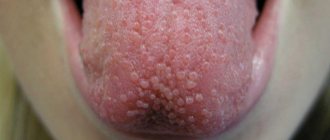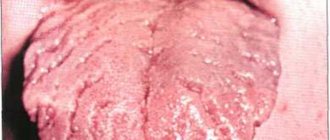From this article you will learn:
- why does an abscess appear on the gum,
- what to do when the gums fester.
The article was written by a dental surgeon with more than 19 years of experience.
A prerequisite for the appearance of gum suppuration is the presence of a source of infection. Most often, this source is an infection in the root canals of the tooth, which develops there either due to poorly performed root canal filling, or due to the patient’s untimely treatment of dental caries or pulpitis. And in this case, the dentist will diagnose you: “Exacerbation of chronic periodontitis.”
The second main cause of gum suppuration is the formation of deep periodontal pockets during periodontitis. Such pockets contain a large amount of infection and can cause the formation of a purulent abscess in the gum. The choice of treatment method will depend on the cause of gum suppuration in your case. Therefore, you first need to determine why pus appeared in the gums, and only then begin treatment.
Content:
- Why does pus come out of the gums?
- Signs indicating a problem
- Causes of pus discharge from the gums
- How do dentists treat pus in gums?
- Additional procedures to help get rid of purulent gum disease
- Recovery after treatment
- Is it possible to cure an abscess at home?
The presence of purulent exudate in the gum tissue is a dangerous symptom that should never be ignored. If it appears, you should immediately consult your dentist. Otherwise, the inflammatory process will progress, which will lead to damage to neighboring structures and premature tooth loss.
Suppuration in a child
If a child has an inflamed gum near a tooth and there are all signs of the onset of purulent processes, there is no need to hesitate - see a doctor immediately. Keep in mind that children have weaker immunity than adults, so any disease progresses rapidly. To avoid serious complications, you need to act quickly.
If a problem occurs in a child, you should immediately consult a doctor
Important! If we are talking about baby teeth, pus can damage the buds of permanent incisors and molars. This will inevitably affect their health in the future, and also risks leading to improper formation of the entire dental system.
Under no circumstances try to pierce an abscess yourself, even if you have antiseptic agents with you for treatment. To relieve acute symptoms before visiting a pediatric dentist, you can have your child rinse their mouth with a weak soda-salt solution. Of course, we are not talking about very young children who may accidentally swallow liquid.
Why does pus come out of the gums?
Suppuration is the result of infection penetrating into the deep tissues of the oral cavity. This is a kind of protective reaction of the body aimed at cleansing the affected area from a dangerous viral, bacterial or infectious agent.
As soon as pathogenic microflora begins to spread inside the gums, blood circulation there increases. Due to this, immune cells are faster delivered to the dangerous focus. As a result, the tissues become red, swollen, and painful to the touch.
Pus in the gums is dead microbes and dead immune cells. As its volume increases, an abscess forms.
Prevention
Regular professional oral cleaning is the key to good dental health. Sanitation removes pathogenic microbes, soft and hard deposits from the mouth. If necessary, treatment procedures are carried out with carious units. To prevent flux from appearing:
- You should brush your teeth every morning and evening.
- The level of hygiene will increase if you use an irrigator or floss.
- Be sure to visit a hygienist at least once every 6 months to care for hard-to-reach areas of the oral cavity.
- It is useful to lead a healthy lifestyle and maintain immunity.
To improve your health, you should give up cigarettes and frequent consumption of strong alcoholic beverages. If you regularly examine the oral cavity yourself, you can notice pathological changes in time.
Signs indicating a problem
A purulent neoplasm is difficult to miss. A person complains about:
- discomfort in the affected area, which intensifies with palpation, pressure, chewing food, and talking;
- unpleasant taste in the mouth (caused by periodic discharge of blood and necrotic masses from the abscess);
- tissue swelling;
- swelling of the cheek (indicates that the inflammation has gone very far and emergency dental care is required).
If the patient continues to ignore the symptoms, his health will worsen. His body temperature will rise, headaches and weakness will appear.
A violent inflammatory process will disrupt the dentogingival apparatus. Then the unit will become mobile and can fall out at any moment.
Symptoms of gum abscess
Gingival abscess manifests itself in two types of symptoms: local and general clinical. Local symptoms are caused by reactive manifestations in the area of inflammation. The appearance of general symptoms is associated with intoxication of the body. The main symptomatic manifestations of the disease:
| Local inflammatory reaction | Symptoms of intoxication |
| pain when pressing on the affected unit; hyperemia of the gums over the area of inflammation; swelling of the tissue around the abscess; smell of rot from the mouth; violation of facial configuration; formation of a tubercle with purulent contents near the tooth; increased mobility of the diseased unit; darkening of tooth enamel; enlargement of nearby lymph nodes. | hyperthermia; dyspnea; cranialgia; violation of orientation in space; tachycardia; aching joints; lethargy; drowsiness; irritability. |
The leading symptom of an abscess is pain. It can be fixed only at the point of inflammation, but more often the discomfort radiates to the head, auricle, eye socket, neck, and neighboring segments. Soreness has different intensity, character (sharp, shooting, dull), occurs periodically in response to stress factors, or is constantly present.
Causes of pus discharge from the gums
The reasons for this phenomenon may be different. Let's name the most common ones:
- Periodontitis. The tip of the tooth root becomes inflamed. This is possible with advanced caries, poorly performed filling, or progressive pulpitis.
- Periodontitis. The dentogingival junction is damaged due to insufficient tissue nutrition, genetic predisposition, and reduced immunity. Food debris begins to accumulate in the resulting pockets, which leads to inflammation and suppuration.
- Gingivitis. Inflammatory gum disease. Bacteria begin to actively multiply due to poor hygiene and traumatic injuries. They penetrate the gums and cause suppuration.
- Periostitis. Chronic or acute inflammation of the periosteum of the jaw. It is the result of the spread of a dangerous infection through the bloodstream or through the lymph. It can also be a consequence of deep caries.
- Osteomyelitis. A purulent infectious-inflammatory process that covers various structures of the jaw and leads to necrosis of many tissues. Osteomyelitis can develop due to mechanical damage, spread of infection through the blood and lymph.
- Pericoronitis. Most often it has to do with a wisdom tooth that has not fully erupted. A voluminous hood of inflamed gums is formed over the unit, under which food accumulates. It serves as an excellent breeding ground for bacteria. Therefore, in the absence of adequate treatment, very soon a person notices that he is secreting pus.
As practice shows, most often pus in the gums appears due to cuts, injuries, or wearing incorrectly selected dental prostheses. Chronic gum damage triggers an inflammatory process that is difficult to stop. Therefore, it is important to pay attention to your oral health. If an inflammatory focus appears, it must be sanitized immediately. This will avoid many complications.
What complications can there be?
It is important not to delay the visit to a specialist, since purulent processes in an advanced stage lead to serious and dangerous consequences. Here are just some of the possible complications:
- root damage and subsequent need for complete tooth extraction,
- purulent damage to bone structures and the development of osteomyelitis,
- formation of granulomas and cysts,
- spread of infection to other organs,
- blood poisoning - sepsis
Purulent processes in an advanced stage lead to serious and dangerous consequences
“Treat your teeth on time!! Don't delay! I once lost a tooth due to an abscess, and I was only 30 years old. Like many, I put off going to the doctor until the last minute. I rinsed with baking soda and salt for several days. As soon as the pain subsided, I decided that everything was over. Yeah, no matter how it is! As a result, after a while it got so bad that I had to rush to the emergency dentistry. It turned out that it’s not just the nerve that needs to be removed, but the entire tooth! Horror! I still really regret that I realized it so late...”
Alexandra V., from correspondence on the woman.ru forum
It is also equally important, after treatment, to strictly follow all the dentist’s instructions and conscientiously follow all his instructions, including taking prescribed medications. Otherwise, after some time you may experience a relapse.
How do dentists treat pus in gums?
Typically therapy includes the following steps:
- Survey. The doctor finds out when the purulent neoplasm appeared, how quickly it grows in size, and how it manifests itself.
- Examination of the oral cavity. The doctor studies the location of the abscess, its color, shape. If necessary, gives a referral for an x-ray of the affected side of the jaw. X-rays are needed to understand the condition of the internal structures.
- Removing food debris, stone and soft plaque from teeth and gums. Sanitation of the oral cavity before treatment of an abscess.
- Opening of a purulent neoplasm. Performed under local anesthesia. First, the patient is given an injection of anesthetic, and then the affected area is carefully dissected. As a result, purulent masses come out.
- Installation of drainage. To prevent exudate from beginning to accumulate in the gums again, a small drainage tube is installed into the incision. You need to walk with her for several days.
A mandatory stage of treatment is anti-inflammatory therapy. The patient is prescribed antibiotics and mouth rinses to prevent the recurrence of a purulent lesion.
It happens that pus is released when pressing on the tooth. In this case, there is no “bump” on the surface of the gum. In this case, the above scheme will be ineffective. The doctor removes the filling (if it was installed), cleans the dental canals and washes out all purulent accumulations. Places a special medicine and closes it with a temporary filling.
On the appointed day, the patient must come for a follow-up appointment. Then the doctor will assess whether the inflammation was removed. If yes, then he will replace the temporary filling with a permanent one; if not, he will re-place the anti-inflammatory composition in the canals and re-install the temporary filling material.
Diagnostics
Looking at the photo of purulent pulpitis, you can see the presence of a deep carious cavity with softened dentin, emitting a putrid odor. The color of dentin can be light in acute forms of the disease, and dark in chronic ones. On the mucous membrane around the diseased tooth you can see a whitish coating and (sometimes) swelling of the transitional fold.
During probing and percussion, a pronounced pain reaction is observed. When you press on the layer that separates the tooth cavity, pus is released and a throbbing pain appears, which subsides as the pus drains. All these signs are identified by a dentist during a visual examination. In addition, radiography and electroodontodiagnostics are prescribed to diagnose the disease.
Differential diagnosis of acute purulent pulpitis requires that this disease be distinguished from:
- diffuse pulpitis in the acute phase - with it there is no pus and pain symptoms are not so intense;
- focal pulpitis - characterized by the absence of purulent discharge and weaker pain;
- purulent periodontitis - characterized by sharp “shooting” pain in the affected tooth at the slightest pressure on it;
- trigeminal neuralgia - there is no feeling of discomfort during thermal exposure, but pain occurs when touching certain points on the face.
Recovery after treatment
After opening and draining the cavity, the body has to mobilize all its resources to speed up the healing process. To help him, it is important:
- comply with all medical prescriptions;
- take medications prescribed by the dentist;
- Healthy food;
- avoid stressful situations;
- dress according to the weather;
- quit smoking and alcohol;
- take a good vitamin and mineral complex;
- carefully monitor oral hygiene, include dental rinse, floss, and irrigator in your daily care.
What to do
The most correct tactic for parents when they discover an abscess on their child’s gum is to go to a dental clinic. The doctor will conduct an examination and determine his further actions, which will be influenced by the stage of the process (the abscess is just forming, has already formed or has ruptured) and the type of tooth (baby or permanent).
It is best if the child visits the dentist in the early stages of development, when the purulent lump has just appeared, but even after the abscess breaks through, the baby still needs to be taken to the doctor to eliminate the source of infection and prevent the abscess from re-forming in the same place or over adjacent teeth.
Is it possible to cure an abscess at home?
Doctors do not allow you to open a flux tumor on your own. This may lead to the addition of a secondary infection. If you are unable to visit a dental clinic in the coming days, you can alleviate the uncomfortable symptoms with the help of:
- Therapeutic and prophylactic rinses. When performing them, you need to use water at room temperature, salt and soda, and pharmaceutical antiseptics.
- Apply cold compresses to the sore cheek.
Under no circumstances should you heat the inflamed area. This will lead to activation of purulent-necrotic processes and the spread of infection, which is very dangerous.
Clinical researches
Clinical studies have proven that regular use of professional toothpaste ASEPTA REMINERALIZATION improved the condition of the enamel by 64% and reduced tooth sensitivity by 66% after just 4 weeks.
Sources:
- Report on the determination/confirmation of the preventive properties of personal oral hygiene products “ASEPTA PLUS” Remineralization doctor-researcher A.A. Leontyev, head Department of Preventive Dentistry, Doctor of Medical Sciences, Professor S.B. Ulitovsky First St. Petersburg State Medical University named after. acad. I.P. Pavlova, Department of Preventive Dentistry
- Clinical and laboratory assessment of the influence of domestic therapeutic and prophylactic toothpaste based on plant extracts on the condition of the oral cavity in patients with simple marginal gingivitis. Doctor of Medical Sciences, Professor Elovikova T.M.1, Candidate of Chemical Sciences, Associate Professor Ermishina E.Yu. 2, Doctor of Technical Sciences Associate Professor Belokonova N.A. 2 Department of Therapeutic Dentistry USMU1, Department of General Chemistry USMU2
- Clinical experience in using the Asepta series of products Fuchs Elena Ivanovna Assistant of the Department of Therapeutic and Pediatric Dentistry State Budgetary Educational Institution of Higher Professional Education Ryazan State Medical University named after Academician I.P. Pavlova of the Ministry of Health and Social Development of the Russian Federation (GBOU VPO RyazSMU Ministry of Health and Social Development of Russia)











